

Friendship Plant Care Tips - Pilea involucrata 'Moon Valley' Botanical Name: Pilea involucrata 'Moon Valley' Friendship Plant has quilted leaves of apple green with deep bronze veins that make it a joy to grow indoors.

This is a bushy, fast-growing plant with ovate leaves that grow in opposite pairs. Pinch off growing tips, if you want, to keep the plant compact. Those cuttings will root easily, so don't toss them out. Share them with friends or pot them up for more plants. Monstera deliciosa. Monstera deliciosa is a species of flowering plant native to tropical rainforests of southern Mexico, south to Colombia.[1] It has been introduced to many tropical areas, and has become a mildly invasive species in Hawaii.
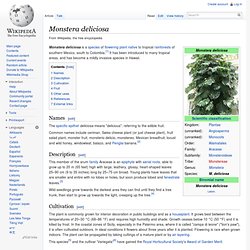
Names[edit] The specific epithet deliciosa means "delicious", referring to the edible fruit. Common names include ceriman, Swiss cheese plant (or just cheese plant), fruit salad plant, monster fruit, monsterio delicio, monstereo, Mexican breadfruit, locust and wild honey, windowleaf, balazo, and Penglai banana.[2] Description[edit] Wild seedlings grow towards the darkest area they can find until they find a tree trunk, then start to grow up towards the light, creeping up the tree.[4]
Date palm. Phoenix dactylifera grows 70–75 feet (21–23 m) in height,[6] growing singly or forming a clump with several stems from a single root system.
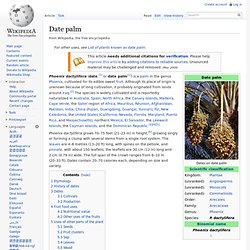
The leaves are 4–6 metres (13–20 ft) long, with spines on the petiole, and pinnate, with about 150 leaflets; the leaflets are 30 cm (12 in) long and 2 cm (0.79 in) wide. The full span of the crown ranges from 6–10 m (20–33 ft). Dates contain 20–70 calories each, depending on size and variety. Etymology[edit] The species name dactylifera "date-bearing" comes from Ancient Greek dáktulos "date" (also "finger")[7] and the stem of the Greek verb ferō "I bear".[8] History of dates[edit] Dates have been a staple food of the Middle East and the Indus Valley for thousands of years. Sansevieria. Etymology[edit] The genus was originally named Sanseverinia by Petagna to honor his patron Pietro Antonio Sanseverino, Count of Chiaromonte (1724-1771), but the name was altered for unknown reasons by Thunberg, possibly influenced by the name of Raimondo di Sangro (1710–1771), prince of San Severo in Italy.
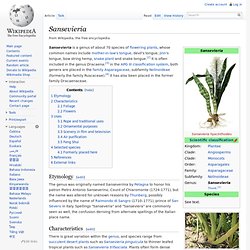
Spellings "Sanseveria" and "Sanseviera" are commonly seen as well, the confusion deriving from alternate spellings of the Italian place name. Characteristics[edit] There is great variation within the genus, and species range from succulent desert plants such as Sansevieria pinguicula to thinner leafed tropical plants such as Sansevieria trifasciata. Aloe Vera : Science and Safety. On this page: Sources Introduction This fact sheet provides basic information about aloe vera—common names, what the science says, potential side effects and cautions, and resources for more information.

Aloe vera’s use can be traced back 6,000 years to early Egypt, where the plant was depicted on stone carvings. Known as the “plant of immortality,” aloe was presented as a burial gift to deceased pharaohs. Historically, aloe was used topically to heal wounds and for various skin conditions, and orally as a laxative. Aloe leaves contain a clear gel that is often used as a topical ointment. Top What the Science Says Aloe latex contains strong laxative compounds. Side Effects and Cautions Use of topical aloe vera is not associated with significant side effects.A 2-year National Toxicology Program (NTP) study on oral consumption of non-decolorized whole leaf extract of aloe vera found clear evidence of carcinogenic activity in male and female rats, based on tumors of the large intestine. Aloe vera.
Aloe vera (/ˈæloʊiː/ or /ˈæloʊ/) is a succulent plant species.

The species is frequently cited as being used in herbal medicine since the beginning of the first century AD. Mimosa pudica. Mimosa pudica (from Latin: pudica "shy, bashful or shrinking"; also called sensitive plant, sleepy plant and the touch-me-not), is a creeping annual or perennial herb often grown for its curiosity value: the compound leaves fold inward and droop when touched or shaken, to protect them from predators, re-opening minutes later.

The species is native to South America and Central America, but is now a pantropical weed. Ficus elastica. Ficus elastica, also called the rubber fig, rubber bush, rubber tree, rubber plant, or Indian rubber bush is a species of plant in the fig genus, native to northeast India, Nepal, Bhutan, Burma, China (Yunnan), Malaysia, and Indonesia.[1] Description[edit] Leaves of Ficus elastica It is a large tree in the banyan group of figs, growing to 30–40 metres (98–131 ft) (rarely up to 60 metres or 200 feet) tall, with a stout trunk up to 2 metres (6.6 ft) in diameter.
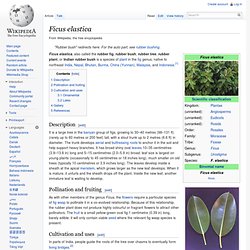
The trunk develops aerial and buttressing roots to anchor it in the soil and help support heavy branches. It has broad shiny oval leaves 10–35 centimetres (3.9–13.8 in) long and 5–15 centimetres (2.0–5.9 in) broad; leaf size is largest on young plants (occasionally to 45 centimetres or 18 inches long), much smaller on old trees (typically 10 centimetres or 3.9 inches long). Agapanthus. Species boundaries are not clear in the genus, and in spite of having been intensively studied, the number of species recognized by different authorities varies from 6 to 10.
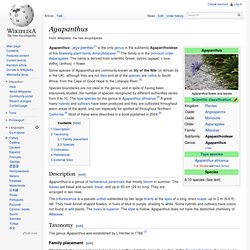
The type species for the genus is Agapanthus africanus.[4] A great many hybrids and cultivars have been produced and they are cultivated throughout warm areas of the world, and can especially be spotted all throughout Northern California.[5] Most of these were described in a book published in 2004.[6] Description[edit] Agapanthus is a genus of herbaceous perennials that mostly bloom in summer. The leaves are basal and curved, linear, and up to 60 cm (24 in) long. They are arranged in two rows. Taxonomy[edit] The genus Agapanthus was established by L'Heritier in 1788.[7] Family placement[edit] Which family the genus belongs to has been a matter of debate since its creation. The table below summarizes the alternative family divisions: Aspidistra. Description[edit] Taxonomy[edit] Species[edit] Aspidistra is a genus that was largely ignored by field botanists until the 1980s onwards, and there has been a very rapid rise in the number of recognised species since then.
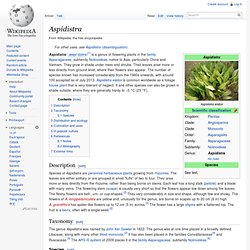
Some 8 to 10 species were known in the late 1970s; 30 new species were described from China in the 1980s. Subsequently more new species were found in Vietnam.